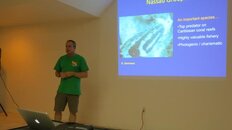It turns out that I'll have to answer my own question on this! Last night I attended a presentation at LCBR given by Brice Semmens, the fellow who has been the guiding force on Project Grouper Moon since the beginning. He and his wife came down here thinking the primary aggregation would be when the evolving conventional wisdom told them it would happen: the first full moon after the winter solstice. This fellow must be one of the top researchers in the world on Nassau Grouper, and he was wrong! They only counted about 1000 Grouper during this aggregation; last year, they estimated over 4500. So now they believe the primary aggregation will occur during the next full moon, in February.
There were two factors contributing to this. First, the water temperature was way warmer than normal. Brice said he measured 83F on his computer, though I only saw 82F on mine. Whatever. It wasn't too many years ago that the conventional wisdom was that the aggregation would happen during the first full moon after the water temperature got down to 77F. Then we had a run of years where the temperature never got below 79F and the aggregation still tended to happen at the first full moon after the winter solstice. The past couple of years the minimum has been at about 78F. Clearly, this year is a bit weird. I've seen 81F, but that's as low as it has gone.
The second confusing factor was the weather. During the days preceding the full moon and even during the full moon we had extremely unsettled weather. The heavy cloud cover obscured the light from the full moon, and we wonder whether that may have affected them.
In any case, it will be interesting to see what February brings. This is one of the great conservation success stories of our time, and I think anybody coming to Little Cayman should familiarize themselves with it before coming. There's plenty of background information at
Grouper Moon Project - Protecting a Caribbean Icon | Reef Environmental Education Foundation (REEF). And be sure to watch the "Changing Seas" video on this. There's a link off the REEF page referenced above. That video was fabulously well done.
Bruce





